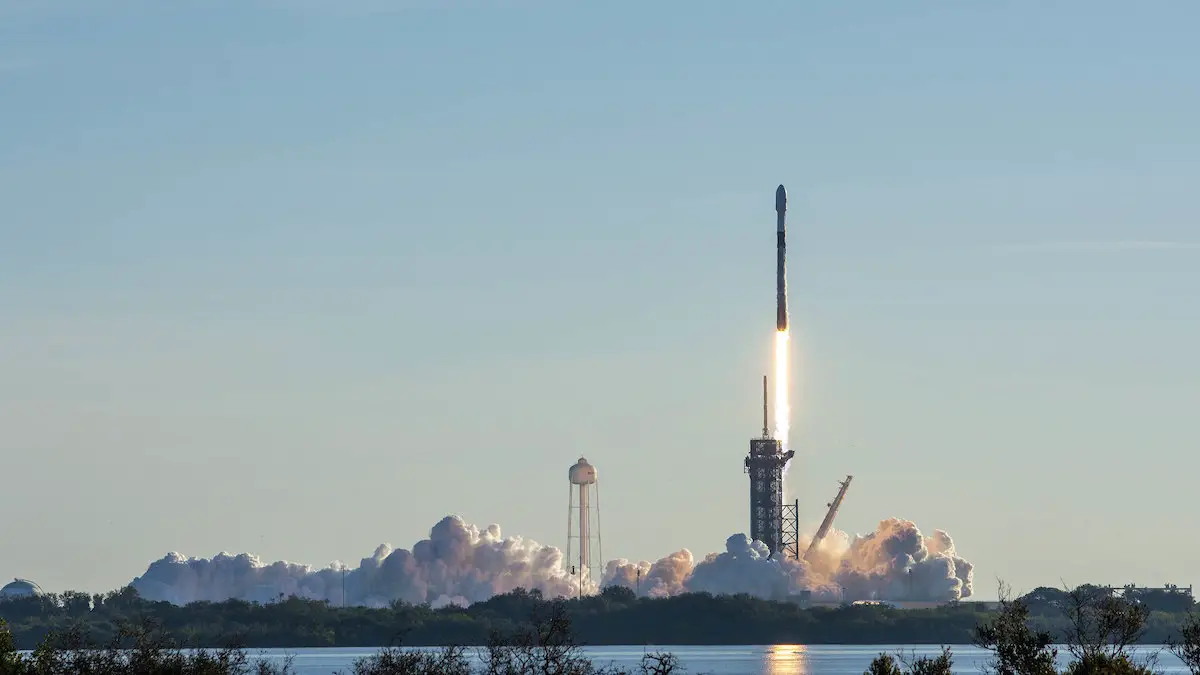WASHINGTON (AP) – With the last launch of Starlink satellites on March 19, SpaceX broke new marks for the number of times its Falcon 9 booster could be reused and the amount of mass the rocket could lift into orbit.
At 12:42 a.m. Eastern, the Falcon 9 rocket blasted off from Space Launch Complex 40 at the Cape Canaveral Space Force Station in Florida. Storms in the vicinity had prevented a launch at 11:24 p.m. Eastern time on March 18, therefore the launch was the second of two possibilities that night.
The Falcon 9 rocket successfully launched 53 Starlink satellites into an orbit at a height of roughly 320 kilometers using a reusable booster. On this flight, SpaceX returned to a northeastern trajectory after numerous earlier Starlink launches had taken place on a southeastern track when sea conditions for booster recovery were more favorable during the winter months.
In a tweet after the launch, SpaceX CEO Elon Musk said that the mission carried the biggest Falcon 9 payload ever flown, weighing 16.25 metric tonnes. That implies that the individual Starlink satellites may weigh up to 306 kilograms apiece, depending on whether or not the weight includes the tensioning rods needed to deploy the satellites and, if so, the mass of those rods. By contrast, the older generation of Starlink satellites weighed around 260 kilos apiece.
According to Jonathan McDowell’s figures, SpaceX has launched a total of 2,335 Starlink satellites with this mission. There are 2,112 satellites in orbit, with 1,575 in operational orbits and roughly 450 more on their way to operational orbits.
SpaceX also achieved a new milestone in the reuse of boosters with the launch of the 12th rocket, called B1051, which successfully landed on a drone-ship in the Atlantic Ocean on its 12th flight. Besides the Demo-1 commercial crew test flight that was flown three years ago, the rocket has also launched the Radarsat Constellation Mission, the SXM-7 radio satellite, and nine Starlink missions, including this one. Two more boosters have flown a total of 11 missions.
Two Crew Dragon missions are postponed
NASA and Axiom Space revealed that their next Crew Dragon flights had been delayed by a few days, only hours before the launch of the Starlink mission, the 11th Falcon 9 mission of 2022.
It was announced on March 18 by Axiom Space that the launch of their Ax-1 mission to the International Space Station, which would transport four commercial astronauts, had been postponed from March 30 to April 3. The corporation said that the four-day delay “would enable crews to finish final spacecraft preparation prior to the voyage.”
The business said that the April 3 deadline is “subject to range availability.” During a briefing on March 14th, NASA revealed that the wet dress rehearsal for the Space Launch System, which arrived at Launch Complex 39B on March 17th, will take place on April 3. Early this year, NASA officials said that LC-39A, which is used for Falcon 9 and Crew Dragon launches, would need to be cleared during SLS launch operations at LC-39B, but that this limitation would not necessarily apply to the wet dress rehearsal flight.
NASA also stated on March 18 that the Crew-4 commercial crew mission, which would launch four NASA and European Space Agency astronauts to the International Space Station (ISS), had been pushed back from April 15 to April 19. Because of orbital mechanics, NASA says the delay will “enable sufficient spacing for operations and post-flight data assessments between human spaceflight missions.” It also says the delay will “allow multiple launch attempts on multiple consecutive days.” The launch date will be confirmed after a review that will take place early next week.
SpaceX Starlink app tops charts in Ukraine
After a public request from Ukraine Vice Prime Minister Mykhailo Fedorov, Musk, the billionaire entrepreneur, delivered the Starlink satellite technology to the country in reaction to the Russian invasion. Fedorov was worried about internet outages during the invasion.
According to Musk, the creator of SpaceX, the service is presently operational and is the only non-Russian communications system that is still operational in certain regions of Ukraine.
Starlink is intended to provide high-speed broadband internet access to areas where connectivity has previously been unstable or unavailable.
According to Sensor Tower, a data analytics company, Starlink was the most downloaded free app on Sunday, with about 21,000 downloads on that one day. According to statistics from Apple’s App Store and Google’s Play store, the majority of downloads came from Ukraine, the company said.
According to Sensor Tower, the Starlink app has been downloaded around 76,000 times in Ukraine, representing a 280 percent increase over the previous two-week period. The first shipment of Starlink terminals landed in the United States around two weeks ago.
The service has proven so vital in Ukraine that Rep. Maria Elvira Salazar, R-Fla., is personally appealing to Musk to bring satellite internet technology to Cuba, similar to what he accomplished in Ukraine. Musk has not responded to a request for comment.
“I applaud Mr. Elon Musk, and I would love for him to do the same thing for Cuba,” Salazar said in a recent interview with Fox News Digital. “We were attempting to communicate with him and his technology because it is essentially conveying the word to those individuals that they are not alone.”
Other than providing internet access to Ukraine, Musk offered to assist by challenging Russian President Vladimir Putin to a single combat and wagering Ukraine in a bizarre tweet to his 78 million Twitter followers on Monday. Musk also offered to assist by challenging Putin to a single combat and wagering Ukraine.

